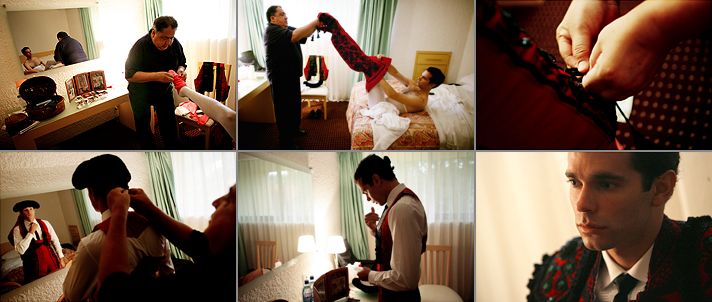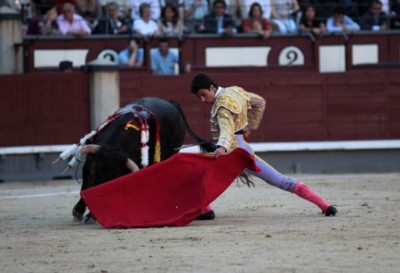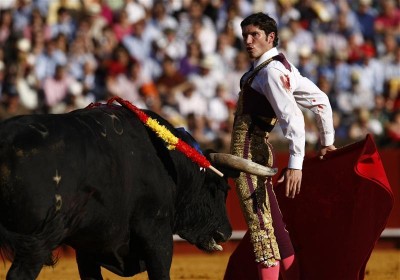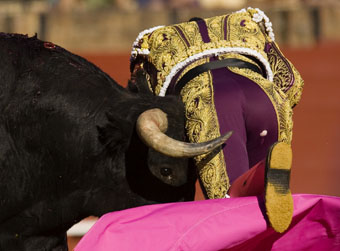Last week Catalonia voted to ban bullfighting in the region. As the world’s cultural heritage is bleeding, should a cultural gem that some consider a blood sport be banned? A lover of arts and animals makes her case for bullfighting as she shares of her affair with the art in Spain.

Bullfighting is the only art in which the artist is in danger of death and in which the degree of brilliance in the performance is left to the fighter’s honour. – Ernest Hemingway, Death in the Afternoon.
Having been awed by the spectacle of bullfighting in Andalucia, I read about Catalonia’s region wide ban on bullfighting with dismay. A living art-form steeped in centuries old traditions is attacked with a flawed, albeit good-intentioned, reasoning. Certain literature even question the Catalan Parliament’s motive in the ban – saying that the move was more about Catalan independence than about animal rights – but I won’t go into that. I can already see buckets of red paint coming my way from animal rightists so I will get on with my point – that the cultural value of bullfighting outweighs the animal suffering it causes. Most people will say they value culture and that they are also against animal cruelty. So this is a subject that needs to be approached with casuistry and not absolutes – bearing in mind that we live in a world where owning an animal and putting it on a collar and lead is called loving it (the only place that’s love is in the bedroom perhaps).
Corrida de toros or fiesta brava is a Spanish fiesta that takes place every March to October. It is national emblem of Spain that is still very much alive and not just some sideshow locals stage for tourists like so many “traditional shows” we see today; complete with “traditional garb” that no one wears or makes anymore! And the moment its intermission time, they’re in denim jeans that are cooler than yours. Don’t you hate those? Doesn’t it leave you feeling so darn touristy and you can feel locals and the well-traveled snickering at you?
We often hear “It’s a dying art/trade/culture/tradition” There few instances in the world, especially in developed countries, where a traditional art-form dating to 1700’s is still hugely popular today with such a wide audience and not just with the elite and “cultured”. Safe for Ricky Gervais, Pamela Anderson, and the fellas who are just waiting for an excuse to splash their naked bodies with read paint for the 7 o’clock news.

The rituals of bullfighting takes place long before a fight begins. It is a tale of interwoven stories of strangers sewn together by the common thread that is bullfighting, much like a Alejandro Gonzalez Innaritu film. The story of the family of matadors, the boy of 8 training to be a matador, the torero that never becomes a matador, the costume makers, the bull breeders, of entire industries and communities that depend on it, the aficionados – some jet-setting and some at village fairs, the awed tourist, of unsung heroes – stable boys, old caretakers of bull pens, and of writers like Welles and Hemingway who created literary classics from the subject of bullfighting.

In Andalucia I visited 2 important cities to bullfighting – Ronda and Sevilla. I visited Ronda first, a small town siting on on two rocky outcrops linked by a 120 meter high bridge that spans the deep canyon. It is home to the oldest operating bullfighting ring in Spain the Plaza de Toros de Ronda. Most of us have seen it in Madonna’s Take A Bow video starring matador Emilio Munoz as her lover.
There were no bullfights scheduled that week in Ronda so I immersed myself in the history of bullfighting at the museum in the Plaza itself. To appreciate, understand, or describe bullfighting one must begin with it’s history.
The shape of its evolution is not precisely as the “sport” of fighting bulls has been documented in the Iberian Peninsular since times of antiquity, during Visigoth rule from 5AD. When the Moors conquered in 711AD they introduced form and ritual to bullfighting.
The Spanish-style bullfighting we see today began taking shape in Ronda, Andalucia in the 1700s -1800s with the contributions of the Romero family of matadors. Francisco Romero introduced the muletta (short red cape) and the estoque (sword). But it was his grandson Pedro Romero who elevated corrida into a highly skilled art and is often credited as the “inventor” of bullfighting as we know it. In the 1900s Cayetano Ordonez would become the first in the Ordonez dynasty of famous matadors. The statue of him and his son, Antonio flanks the gates to the Ronda bullring.

I made sure that my trip to Sevilla coincided with the world famous bullfighting festival, Feria de Abril. It was at the Plaza de Toros de Maestranza in Sevilla that I truly fell in love with the corrida.
This highly ritualised sport is an act in 3 parts, performed by a cuadrilla (entourage) of 6 toreros – 1 matador, 2 picadores (mounted lancers), 3 banderilleros (flagsmen), and 1 mozo de espada (sword page). In one evening, up to 3 entourages may be featured and each matador will have to take on 2 bulls. A common misconception is that by the time the picadores and banderilleros have completed the 1st and 2nd acts, the bull is weakened thus making the matadors job easy. The bull is worn but it has also been provoked and senses that the matador is a real danger. The manouveres of the matadores also require a higher level of skill. In fact most gores happen during the 3rd Act – faena.

Enter the matador: He walks tall with a gait that tells of the years of training and dedication to the art. Only a torero can pull off bright pink tights with a heavily embroidered cropped jacket and tassled pointy-toed ballet flats and come off projecting macho-ness! It sounds funny but these traje de luces (suits of light) that are rooted in 18th century Andalucian dress, are bespoke and cost several thousand euros.

The deft footwork, the flick of the wrist, the seamless transition from maneuver to another, the arching of the body as matador slowly sweeps the cape on the red earth as he wills the bull to pass through it, the closer the horns to his body the better, and the swift turnaround to the forceful finish as he stands tall again, drinking in the crowds cheers of Ole!


Sometimes we catch glimpses of courage cracking ever so slightly – in the split second of hesitation in a young matador, when a matador has to walk off after being tackled – the crowd is unforgiving. He will hear sighs if he’s lucky, but mostly it’s hissing and jeers and cheers for the bull instead. This gets worse his execution of the estocada fails to despatch the bull swiftly and cleanly.


Watching a person (there are now female matadors too, talk about grabbing equality by the horns!) face off a beast bred for one purpose only – to charge, one can’t help but to be inspired at the raw-courage and tranquility in adversity that the human mind is capable of. The great battle is not between matador and bull but it is the inner struggle within the matador – pushing the limits of his survival instincts as he continues to increase personal danger, straddling suicideand success, life or art!


The ritual for the Spanish people are only halfway through when the fight draws to a close. The sea of people flowing out of the plaza gates will fill every tapas bar in the old town quarter, spilling onto the pavements and filling every cobblestone corner with the sound of camaraderie and laughter. It’s also quite a visual pleasure because everyone looks like they walked out of a Zara ad! The Spanish are effortlessly stylish to begin with and they do dress up to go to bullfights, almost Sunday best I’d say. Men in summer suits, linen jackets or a crisp shirt with sweater slung over shoulders. Womyn in tailored blouses, summer frocks, and the ubiquitous oxford shirt and capri pants combo.
Spirited goodbyes are exchanged (the Spanish can be a little loud, but not jarring unlike the Italians) amidst the clickity-clack of footsteps leaving the town. That is how I remember my spring in southern Spain.
Walk through the bullfighting museum, drink in the experience live in the Plaza or vicariously through the likes of Hemingway and Orwell. If you still feel its animal cruelty, you can put down the picket and suck it until you decide not to put calf, cows, little lambs, and poorly housed hens through cruelty. Not to be glib – but at least these bulls had a fighting chance – I’m pretty sure your “cap lembu” Braun Buffel wallet didn’t and neither did your Ferragamo shoes. As an afterthought, Malaysians shouldn’t be too riled up about bullfighting being cruel – after all cow heads are quite the ornament here.
Seeing bullfighting as a bloodsport is but only one dimension of this multi-faceted cultural gem.
Ole!





Thankyou regarding delivering a really exceptional info. We might love providing him or her with the people acquiring sociable internet websites. You must certainly maybe end up being modernize employing your website, i'm day-to-day buyer on the website. supply cheers yet again.
Thanks for your posting. My partner and i have continually seen that almost all people are wanting to lose weight because they wish to appear slim and also attractive. Even so, they do not often realize that there are additional benefits just for losing weight additionally. Doctors state that fat people experience a variety of disorders that can be instantly attributed to their particular excess weight. The good thing is that people who're overweight along with suffering from a variety of diseases can help to eliminate the severity of their illnesses by way of losing weight. You possibly can see a slow but noticeable improvement with health whenever even a slight amount of fat loss is obtained gywl512.
Nice piece. Perhaps some culture are meant to go into history books. I sense a lot of spirituality reasons behind the ban. Just like how the British abolished age old culture of burning the widow with the husbands corpse in India, and child sacrifice in some worships. Watch Indiana Jones, The Temple of Doom. Going back to Bullfighting, as much as it is rich in culture, we have to admit it is a form of cruelty towards animals. I go speechless when some of my animals rights activist friends say “bullfighting is a systematic torture killing that pits a Man against and wounded animals.” Even the religious lot would look down upon bullfighting… In 1567 Pope Pius V issued a papal bull condemning bullfighting and other forms of animal fighting for entertainment as “cruel and base spectacles of the devil” whose promoters are subject to excommunication. So in that sense, well sometimes we have to put somethings into history…
Thank you, Lings :) I'm actually quite chuffed you even read my article. However… here comes the but ;)
You drew a parallel between cultural practices that have been outlawed because it robbed another human being of their right to life and the banning of bullfighting. Human rights and animal rights are not on the same platform, not that I condone animal cruelty, but we do eat them, wear them, ride them, and put them of a leash, and give them ridiculous names like JoJo and Pookie. Why isn't cattle farming a systemic breeding and culling of animals? Because it ends ups as food and we rationalise it as human sustenance?
Popes in that era were more powerful than politicians and monarchs had to seek their support – like when Queen Elizabeth wanted to banish her cousin Mary Queen of Scots, or march into another man's land and convert them so that their souls will be saved. Like politicians – their stand on policies must be carefully examined to see if its self-serving and flexible to his needs or the peoples'.
In 1567 Pope Pius V issued a decree banning bullfighting, believing that the matadors voluntarily endangering their lives which also endangered their souls. This was overturned eight years later by his successor, Pope Gregory XIII, at the request of king Philip II.
This argument does not retain water, unlike <del datetime="2010-08-28T08:47:42+00:00">your</del> my thighs.